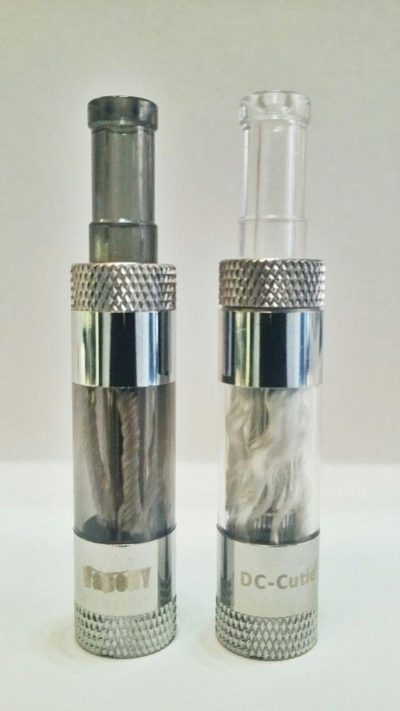By Tim Donnelly | September 19, 2013

Photo: Anthony Causi
It’s the middle of New York Fashion Week and the stylish crowd of celebs, designers and wannabes are filing into the front row. As the models sashay down the runway, a puff of what looks like white smoke rises from the crowd, but no one seems to mind.
It’s not a carcinogen cloud, but vapor from Njoy, an electronic-cigarette brand that looks just like the real thing.
The e-cigs were a popular freebie at this month’s style summit, with fashionistas stuffing packs of the reusable, smokeless products into their Fendi bags, allowing them to get their nicotine fix anywhere, smoking bans be damned.
“It was great because you are in a space where you would be obnoxious to smoke or you wouldn’t be allowed to,” says stylist Kathleen Clements, a 32-year-old social smoker from Williamsburg. “You’ve been drinking, you’ve been working really hard. What pairs really well with that is a cigarette in your hand.”

A woman smokes an e-cig while taking in the Nautica collection at New York Fashion Week.Photo: Jennifer Polixenni Brankin
But just as e-cigs are catching on citywide — with new specialty shops opening on the Lower East Side and in Williamsburg — they’re facing a big backlash among public health advocates. Should the devices be treated like real cigarettes or viewed as a socially acceptable alternative for those looking to kick the habit?
Instead of burning tobacco, e-cigs use battery power to heat up an oil containing nicotine and often a flavor, from menthol to pineapple. The resulting puff is as harmless as flavored water — at least according to proponents. Users don’t call it smoking because there is no smoke; they “vape” it.
Whether e-cigs pose any major health risks is still unclear: Some studies say the nicotine isn’t particularly harmful to the user; some health officials say more research needs to be done to find out what exactly is in the oil, and what is being inhaled.
And the rules and etiquette about where and when to use them are equally murky.
The City Council is considering legislation that would ban flavored-nicotine products — what vapers call a backdoor ban on e-cigs, since flavors can be part of their appeal. It could also prohibit the display of e-cigs in retail shops, and could limit some brands to tobacco bars.
A City Council staffer who declined to be named said the bills didn’t directly target e-cigarette users, who attended public hearings earlier this year to voice their concerns. (The council is considering that input before bringing the bill back for discussion in the next few months.)
Meanwhile, New Jersey already bans the use of e-cigarettes in indoor public spaces throughout the state, and other cities around the country are considering doing the same.
“It’s a ploy. [The tobacco companies] know what they’re doing,” says New Jersey state Sen. Joseph Vitale (D-Middlesex), one of the sponsors of the 2009 bill to ban indoor e-cigarette use in a bid to keep kids from taking up the habit. “It’s addictive still, it’s harmful still. And we’re trying to not create another generation of addicted smokers.”
The market currently is unregulated, but the US Food and Drug Administration is expected to finally issue rules next month that could affect how the devices are sold — and how they’re advertised.
Metro-North and the Long Island Rail Road have both banned e-cigarettes on trains and platforms. (An LIRR spokesman says chewing tobacco is permitted, while spitting is not.) The Metropolitan Transportation Authority hasn’t issued an official ban for subways yet, but use of the devices there is discouraged. And while a Transportation Security Administration spokesman says you can bring e-cigs through airport security, many airlines have enacted bans on using them in planes.
Meanwhile, across the city, restaurant and bar owners are scratching their heads — with some spots encouraging their use, and others, such as Williamsburg’s Brooklyn Bowl, outright banning them. (A Brooklyn Bowl bouncer says it’s too hard to tell the difference between nicotine vapor and what’s produced by hand-held marijuana vaporizers, which are illegal to use.)
But ex-cigarette smokers who now vape say such bans are as good as handing them back their pack of Camels. Cut down on e-cig use indoors, they say, and you’ll just go back to encouraging smokers to form that annoying gauntlet of carcinogens that blocks the entrance to every bar and club in the city.
“The more you restrict this product from being used, the less smokers will find out about it, the more barriers to [vaping] there are,” says Russ Wishtart, 36, who smoked for about 20 years before switching to e-cigs three years ago.
Another vaper, Antoinette Lanza, 33, of Hoboken, says she worries about falling back into her old pack-a-day habit if she’s forced to share the same sidewalk space with smokers: “When everyone is smoking, you almost want to pick up a cigarette again. All it provides is temptation. It really shows that we’re going away from the cigarettes and to a better alternative.”
So far, early research supports this.
According to a study released this summer by the School of Public Health at Drexel University, “By the standards of occupational hygiene, current data do not indicate that exposures to vapers from contaminants in electronic cigarettes warrant a concern.” Still, researchers did note more study was needed to look at long-term secondhand effects.
And while the nicotine in e-cigarettes is addictive, it doesn’t contain harmful additives such as cyanide and formaldehyde found in regular cigarettes.
“[Nicotine is] not harmful in and of itself,” says Patricia Folan, director of the Center for Tobacco Control at the North Shore-LIJ Health System in Great Neck, LI. “Except that it’s the chemical that keeps people addicted to smoking. It’s not the one that causes all the heart disease.”

Chloe Cappo, 19, is a member of the vaper club.Photo: Anne Wermiel
Vapor can, however, contain a scent, so a room full of e-cig users can smell like vanilla, blueberry or mango. It stays on your skin a bit if you’re in a vape-heavy setting, and can tickle your throat a bit, too (at least it did for this reporter).
But vapers, such as Spike Babaian, who opened Vape NY, Manhattan’s first e-cig store, on Rivington Street this summer, say the scent is comparable to any other urban odor.
“The lady that sits next to me on the subway is wearing perfume that smells like lavender, and I hate the smell of lavender,” she says.
The American Cancer Society calls the spread of e-cig use “intriguing,” but isn’t quite ready to endorse its use until the FDA weighs in.
“We’re certainly keeping our eyes on it,” says Thomas Glynn, director of international cancer control for the American Cancer Society. “We’d welcome anything that would continue to help people stop smoking.”
That’s a sentiment shared by some local business owners, who view vapers as preferable to traditional tobacco smokers.
“You want to yell at them, but then you realize what it is,” says Aaron Allietta, manager of the bar and restaurant ’inoteca on Rivington Street. “If you have an e-cig, we have no problem with that.”
Employees at two nearby spots, Spitzer’s Corner and the Cake Shop, both said they allow customers to vape indoors, as did a bouncer at Union Hall in Park Slope.
But detractors say that after decades of forcing nicotine users into the margins of society, e-cigs could welcome them back to the dinner table.
“We’ve kind of denormalized smoking,” says Folan, citing measures such as high tobacco taxes and bans in NYC parks.
“It’s pushed people who are smokers to actually quit — or think about it, at least. It may make it seem normal again if we see all these people using [e-cigs] indoors.”
For the first time in decades, ads in print and TV (featuring celebs such as Stephen Dorff and Jenny McCarthy) hawk nicotine via e-cigs in a way not seen since tobacco companies tried to make cigarettes look stylish in the 1960s.
Shops offer a wide selection — from the “cig-a-like” kinds that you can find at bodegas citywide, to more complicated digital vaporizers.
Users are also known to bling out their devices with interchangeable plastic tips or jewels.
And nicotine refills are available in flavors such as watermelon candy, root beer and juicy fruit.
That has some parents concerned that kids will be sucked into the allure of the new trend. A Centers for Disease Control and Prevention study released earlier this month found that the percentage of high-school and middle-school students who have tried an e-cig more than doubled in the past two years. Some of them had never tried a traditional cigarette.
Many local shop owners say they self-regulate and won’t sell to minors, but since the FDA has yet to weigh in, anyone can buy them online or elsewhere.
Talk to e-cig users, and they’ll almost universally praise how switching to the devices helped them “quit” puffing all the carcinogens and tar in regular cigarettes.
But “quitting” seems like a stretch for a habit that still has them sucking in nicotine — often more frequently than they would walking outside to have a cigarette. Are they kidding themselves?
“I say it’s a bad move because they’re going to get the same physiologic pattern that tobacco cigarette smoking is giving them,” says Dr. Len Horovitz, an internist and pulmonary specialist at Lenox Hill Hospital, referring to the resulting nicotine spike in the bloodstream.
“It may not be as dangerous as smoking, but that doesn’t mean it’s without danger.”




